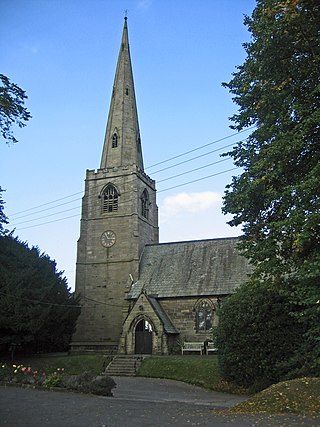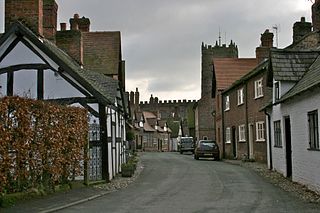
St John the Evangelist's Church is located to the north of the village of Ashton Hayes, Cheshire, England. It is an active Anglican parish church in the diocese of Chester, the archdeaconry of Chester and the deanery of Chester. The church is recorded in the National Heritage List for England as a designated Grade II listed building.

Great Budworth is a civil parish in Cheshire West and Chester, England. The parish contains 59 buildings that are recorded in the National Heritage List for England as designated listed buildings. Other than the village of Great Budworth, the parish is entirely rural. Most of the listed buildings are houses, or buildings relating to farming, a high proportion of which are located within the village itself. The village is described by Norman Bilsborough as being "probably one of the best-known villages in Cheshire", and Claire Hartwell et al. writing about the village in the Buildings of England series state "the immediate surroundings of the church make one of the best pieces of villagescape in the county". The village is located in what was part of the estate of Arley Hall. Between the 1860s and the end of the 19th century the owner of the hall, Rowland Egerton-Warburton, commissioned the restoration of existing buildings in the village and the construction of new ones. To this end he employed architects working in the Vernacular Revival style, including John Douglas, Edmund Kirby, and William Eden Nesfield. Douglas' biographer Edward Hubbard states that Egerton-Warburton had a "campaign to restore the village and render it picturesque in Victorian eyes". Almost all the buildings in the centre of the village, those in Main Street, Church Street, and School Lane, are listed.
Utkinton is a former civil parish, now in the parishes of Utkinton and Cotebrook and Tarporley, in Cheshire West and Chester, England. It is entirely rural, and contains the villages of Utkinton and Cotebrook. The A49 road runs through it in a north–south direction. The parish contains 13 buildings that are recorded in the National Heritage List for England as designated listed buildings. One of these, Utkinton Hall, is listed at Grade I, and all the others are in Grade II. Other than the hall, some of the listed buildings are associated with the hall, and the others are domestic buildings, or related to farming. In Cotebrook, the church and its former parsonage are listed.
Barrow is a civil parish in Cheshire West and Chester, England. It contains 13 buildings that are recorded in the National Heritage List for England as designated listed buildings. Other than the settlements of Great Barrow and Little Barrow, the parish is entirely rural. Apart from the church, a sundial, and a war memorial, all the listed buildings are domestic or related to farming.

Ince is a civil parish in Cheshire West and Chester, England. It contains 25 buildings that are recorded in the National Heritage List for England as designated listed buildings. One is these is of these listed at Grade I, the highest grade, one at Grade II*, the middle grade, and the rest are at the lowest grade, Grade II.
Kelsall is a civil parish in Cheshire West and Chester, England. It contains six buildings that are recorded in the National Heritage List for England as designated listed buildings, all of which are at Grade II. This grade is the lowest of the three gradings given to listed buildings and is applied to "buildings of national importance and special interest". Much of the parish is occupied by the village of Kelsall, with the rest of the parish rural. The listed buildings consist of farmhouses, farm buildings, a church and a lock-up.
There are over 20,000 Grade II* listed buildings in England. This page is a list of these buildings in the unitary authority of Cheshire West and Chester.
Shotwick is a former civil parish, now in the parish of Puddington, in Cheshire West and Chester, England. It contains 23 buildings that are recorded in the National Heritage List for England as designated listed buildings. Of these, one is listed at Grade I, the highest grade, two are listed at Grade II*, the middle grade, and the others are at Grade II. Apart from the village of Shotwick, the parish is entirely rural. Most of the listed buildings are in the village, and include houses, St Michael's Church and structures in the churchyard, and Shotwick Hall with associated structures. Outside the village, the listed buildings are domestic or related to farming.
Tarvin is a civil parish in Cheshire West and Chester, England. It contains 27 buildings that are recorded in the National Heritage List for England as designated listed buildings. Of these, one is listed at Grade I, the highest grade, two are listed at Grade II*, the middle grade, and the others are at Grade II. The parish contains the village of Tarvin, and is otherwise rural. The listed buildings include the village church and structures in the churchyard, houses, cottages, a shop, a war memorial, and a public house. Outside the village they are houses and farmhouses.
Thornton-le-Moors is a civil parish in Cheshire West and Chester, England. It contains nine buildings recorded in the National Heritage List for England as designated listed buildings. Of these, one is listed at Grade I, the highest of the three grades, and the others are at Grade II, the lowest grade. Apart from the village of Thornton-le-Moors, the parish is rural, other than the area north of the A5117 road, which is occupied by an oil refinery. The listed buildings consist of the village church and associated structures, houses, farmhouses, and farm buildings.
Acton is a civil parish in Cheshire East, England. It contains 24 buildings that are recorded in the National Heritage List for England as designated listed buildings. Of these, two are listed at Grade I, the highest grade, four are listed at Grade II*, the middle grade, and the others are at Grade II. Apart from the village of Acton, the parish is rural. Listed buildings in the village include the church and associated structures, houses, a public house and a telephone kiosk. The major structure is the parish is Dorfold Hall; this and associated structures are listed. The other items include an aqueduct carrying the Shropshire Union Canal across a road, farmhouses and cottages.
Audlem is a civil parish in Cheshire East, England. It contains 25 buildings that are recorded in the National Heritage List for England as designated listed buildings. Of these, two are listed at Grade I, the highest grade, one is listed at Grade II*, the middle grade, and the others are at Grade II. The major settlement in the parish is the village of Audlem. In the village the listed buildings include churches and cemetery chapels, a former grammar school, a hotel, houses, and a memorial lamp standard. In the surrounding countryside the listed buildings include country houses, farmhouses, farm buildings, and a road bridge. Running through the parish is the Shropshire Union Canal, and the listed structures associated with this are bridges, mileposts and a lock keeper's cottage.
Barthomley is a civil parish in Cheshire East, England. It contains 15 buildings that are recorded in the National Heritage List for England as designated listed buildings. Of these, one is listed at Grade I, the highest grade, two are listed at Grade II*, the middle grade, and the others are at Grade II. Apart from the villages of Barthomley and Englesea Brook, the parish is entirely rural. Most of the listed buildings are houses or farmhouses, many being timber-framed and dating from the 17th century. The exception are a church, a public house, and a former smithy.
Brereton is a civil parish in Cheshire East, England. It contains 21 buildings that are recorded in the National Heritage List for England as designated listed buildings. Of these, one is listed at Grade I, the highest grade, three are listed at Grade II*, the middle grade, and the others are at Grade II. The parish is almost entirely rural. The major building in the parish is Brereton Hall. The listed buildings consist of the hall and associated buildings, the church and a sundial in its churchyard, a public house, a former mill, farmhouses and farm buildings, houses or cottages, and three mileposts.
Church Minshull is a civil parish in Cheshire East, England. It contains 22 buildings that are recorded in the National Heritage List for England as designated listed buildings. Of these, four are listed at Grade II*, the middle grade, and the others are at Grade II. Apart from the village of Church Minshull the parish is rural. A high proportion of the listed buildings are houses or cottages, many of which are timber-framed, and date back to the 17th century. The Middlewich Branch of the Shropshire Union Canal and the River Weaver pass through the parish. Three structures associated with the canal are listed, a bridge, an aqueduct, and a former warehouse. The other listed buildings are farmhouses, farm buildings, the village church and its gates, a public house, and two bridges.
Cranage is a civil parish in Cheshire East, England. It contains 12 buildings that are recorded in the National Heritage List for England as designated listed buildings. Of these, one is listed at Grade II*, the middle grade, and the others are at Grade II. Apart from the village of Cranage, and some residential areas, the parish is rural. Most of the listed buildings are houses and cottages, or farmhouses and farm buildings. The other listed buildings are a former country house, a former vicarage, a school, a bridge, and a milepost.
Goostrey is a civil parish in Cheshire East, England. It contains 19 buildings that are recorded in the National Heritage List for England as designated listed buildings. Of these, one is listed at Grade I, the highest grade, three are listed at Grade II*, the middle grade, and the others are at Grade II. Apart from the village of Goostrey, the parish is mainly rural. It contains the Jodrell Bank Observatory, with its Grade I listed Lovell Telescope and its control building. In the village, the listed buildings include the church and associated structures, the former schoolmaster's house, and a row of cottages. Outside the village they include country houses, farmhouses, and farm buildings, some of which date back to the 16th century and are timber-framed.
High Legh is a civil parish in Cheshire East, England. It contains 12 listed buildings, which are designated by English Heritage and recorded in the National Heritage List for England. Of these, two are listed at Grade II*, the middle grade, and the others are at Grade II. Apart from the village of High Legh, the parish is mainly rural. Most of the listed buildings are houses, cottages, and farmhouses, some of them dating back to the 16th and 17th centuries, and timber-framed. The other listed buildings are a chapel and a church.
Worsthorne-with-Hurstwood is a civil parish in the borough of Burnley, Lancashire, England. The parish contains 22 buildings that are recorded in the National Heritage List for England as designated listed buildings. Of these, four are listed at Grade II*, the middle grade, and the others are at Grade II, the lowest grade. Apart from the village of Worsthorne and the settlement of Hurstwood, the parish is rural. Most of the listed buildings are farmhouses, or originated as farmhouses or farm buildings. Other listed buildings include large houses and associated structures, a row of former back-to-back cottages, a church, and a telephone kiosk.
Ashton-under-Lyne is a town in the Tameside, Greater Manchester, England. The town and the countryside to the north contain 51 listed buildings that are recorded in the National Heritage List for England. Of these, one is listed at Grade I, the highest of the three grades, seven are at Grade II*, the middle grade, and the others are at Grade II, the lowest grade.





